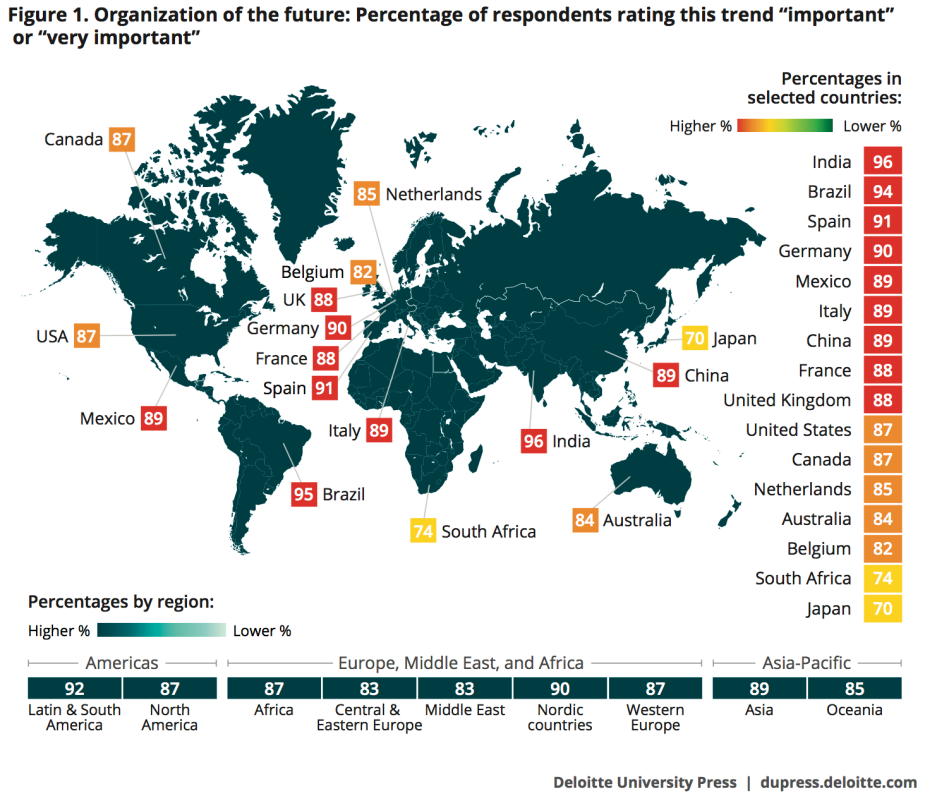I’ve documented in previous posts that the largest companies in the world (an increasing number of which are technology companies) have experienced and continue a experience a sustained shift in revenue, assets and employees away from domestic markets and toward foreign markets. As all industries become digitalized, the opportunity and need for global workforce mobility grows as well. The reality is that we are living in a post-globalization world. Globalization is no longer the new hot trend. Businesses now struggle not with “going global” but rather with “being globalized.”
As businesses orient within a firmly globalized landscape, most find that new models for organizing employees are required. In the Deloitte’s 2017 Global Human Capital Trends study indicate that 88% of surveyed executives believe organizational design to be very important or important to their future success. This means designing organizations for the digitalized workplace by building in high degrees of adaptability and agility. These goals are difficult to achieve in the traditional hierarchical corporate structure. Indeed, only 14% of polled executives believe that the traditional organizing principals are effective. The need for adaptability and agility are magnified when you take into account the millennial penchant for job-jumping.

What’s the solution?
Many companies are shifting to collaborative models, whereby employees participate on a number of more egalitarian teams within an ad hoc network. Some are implementing profound changes in organizational philosophy, such as the model of self-organization promoted by Frederic Laloux in Reinventing Organization. The Laloux model assigns a much higher degree of importance to the higher purpose of an organization and to individuals defining their own responsibilities in the organization, with peer engagement at the core of accountability and agile decision-making.
With global agile teams on the rise, we seeing ever more teams composed of individuals from diverse cultures, living in every corner of the globe. Even as business grapples with how to manage new organizational models with relatively homogeneous groups of employees in their domestic markets, the challenge is made doubly complex when we add cross-cultural collaboration to the mix. Research suggests that “cultural diversity leads to process losses through task conflict and decreased social integration, but to process gains through increased creativity and satisfaction.” This indicates that more work is required to ensure that process loss may be avoided by training employees on the cultural characteristics that may lead to conflict or social disintegration. That’s where Idiosynch comes in.
How does cross-cultural team-building work?
Idiosynch leads teams through a robust process that identifies key objectives, breaks down existing preconceptions, raises awareness of cultural differences and delivers shared organizing principles and systems that ensure long-term success. Each client program is customized to fit budgetary and operational constraints.
Step 1: Mapping the challenge
Idiosynch begins by working with your senior leadership to define the scope of the challenge and the desired outcomes.
- Identify all stakeholders & relevant cultural backgrounds
- Document existing concerns, past organizational experiences
- Discover existing corporate tools and frameworks
- Describe what success looks like
- Set timelines for engagement
Step 2: Getting buy-in
We then work with team member to raise cultural awareness, both of oneself and others, and build excitement for the process.
- Define personal cultural predisposition and external prejudices
- Explore the dimensions of cultures
- Discuss prejudice versus reality
- Learn how to short-circuit conflict
- Describe successful cultural leadership
- Expat preparation – before and after the assignment
Step 3: Building a shared vision
Everyone on the team comes together to set expectations for communications and develop custom ground rules for engagement and everyone has a stake in honoring.
- Understand management objectives by applying the right cultural lens
- Explore perceptions of individual roles, how people fit into a team or hierarchy
- Discuss views of individual purpose versus team purpose
- Set operational expectations (emailing, meeting dynamics, scheduling, etc.)
- Define process for addressing cultural gaps and disconnects
Step 4: Keep the engine tuned
Develop a plan for ongoing touchpoints and refresher training to ensure that new teammates are properly oriented and to allow for continuing evolution of the strategy.

